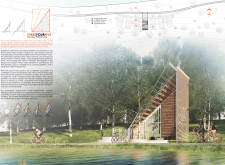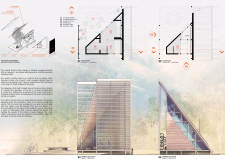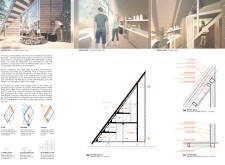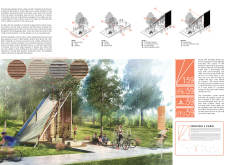5 key facts about this project
The ThreeFourFive cabin is an architectural project designed to serve cycling enthusiasts seeking rest areas along biking paths. This structure is organized around a simple geometric concept, utilizing three horizontal, four vertical, and five diagonal components which reflect an efficient assembly and straightforward structural organization. The project’s design underscores clarity and functionality, ensuring ease of construction while minimizing its ecological footprint through the use of sustainable materials.
Materiality and Structural Features
The ThreeFourFive cabin is constructed with locally-sourced wood for its cladding, which integrates seamlessly with the natural surroundings. Recycled steel forms the structural framework, offering both lightness and strength. The roof features an inclined design that not only enables effective rainwater collection but also accommodates solar panels for energy efficiency. The cabin stands elevated on hollow structural steel columns, minimizing ground disturbance and enabling a quick assembly process.
Designed with sustainability in mind, the project incorporates passive design principles to enhance thermal performance and incorporates systems for water management. A shared kitchen area facilitates communal living, while the sleeping areas are compact, efficiently utilizing vertical space. The interior layout includes large openings that enhance natural light and improve ventilation, optimizing the user experience within the cabin.
Unique Design Approaches
One of the standout features of the ThreeFourFive cabin is its modularity, allowing for flexibility in deployment along diverse landscapes. The assembly process is designed to be straightforward, requiring minimal groundwork and enabling rapid on-site construction. This adaptability extends to the material selection, as the cabin can be customized to utilize local resources depending on site conditions.
This project also incorporates a strong emphasis on community engagement. The design encourages interaction with shared spaces, facilitating social connections among cyclists and outdoor enthusiasts. By framing the functional aspects of the cabin around community-oriented features, the project promotes a collaborative atmosphere conducive to rest and recreation.
Sustainable Practices and Environmental Harmony
The ThreeFourFive cabin exemplifies a thoughtful integration of architecture and environment. Its elevated design, combined with rainwater harvesting systems and solar energy solutions, highlights a commitment to sustainability. The architectural choices made in this project reflect an understanding of the surrounding ecosystem, ensuring that the structure complements rather than disrupts its natural environment.
Through innovative design and careful consideration of materials, the ThreeFourFive cabin serves as a model for future developments along cycling routes. Interested readers are encouraged to explore the comprehensive project presentation for further insights into the architectural plans, sections, and ideas that underpin this thoughtful design.























































